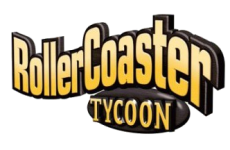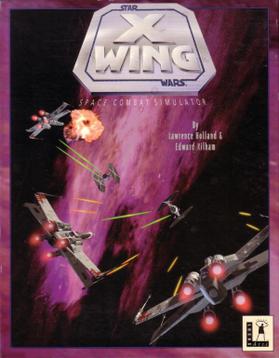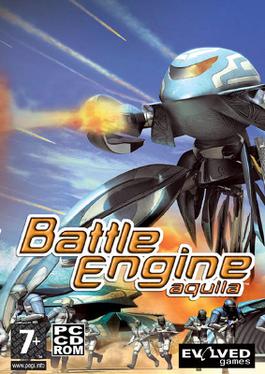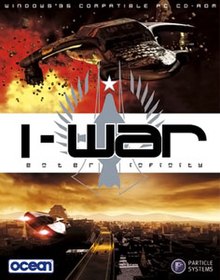
Asteroids is a space-themed multidirectional shooter arcade video game designed by Lyle Rains and Ed Logg released in November 1979 by Atari, Inc. The player controls a single spaceship in an asteroid field which is periodically traversed by flying saucers. The object of the game is to shoot and destroy the asteroids and saucers, while not colliding with either, or being hit by the saucers' counter-fire. The game becomes harder as the number of asteroids increases.

Atari is a brand name that has been owned by several entities since its inception in 1972. It is currently owned by French company Atari SA through a subsidiary named Atari Interactive. The original Atari, Inc., founded in Sunnyvale, California, in 1972 by Nolan Bushnell and Ted Dabney, was a pioneer in arcade games, home video game consoles, and home computers. The company's products, such as Pong and the Atari 2600, helped define the electronic entertainment industry from the 1970s to the mid-1980s.

Star Control: Famous Battles of the Ur-Quan Conflict, Volume IV is an action-strategy video game developed by Toys for Bob and published by Accolade. It was originally released for MS-DOS and Amiga in 1990, followed by ports for the Sega Genesis and additional platforms in 1991. The story is set during an interstellar war between two space alien factions, with humanity joining the Alliance of Free Stars to defeat the invading Ur-Quan Hierarchy. Players can choose to play as either faction, each with seven different alien starships which are used during the game's combat and strategy sections.

Neverwinter Nights is a third-person role-playing video game developed by BioWare. Interplay Entertainment was originally set to publish the game, but financial difficulties led to it being taken over by Infogrames, who released the game under their Atari range of titles. It is the first installment in the Neverwinter Nights series and was released for Microsoft Windows on June 18, 2002. BioWare later released a Linux client in June 2003, requiring a purchased copy of the game to play. MacSoft released a Mac OS X port in August 2003.

Descent: FreeSpace – The Great War, known as Conflict: FreeSpace – The Great War in Europe, is a 1998 space combat simulation IBM PC compatible computer game developed by Volition, when it was split off from Parallax Software, and published by Interplay Productions. In 2001, it was ported to the Amiga platform as FreeSpace: The Great War by Hyperion Entertainment. The game places players in the role of a human pilot, who operates in several classes of starfighter and combats against opposing forces, either human or alien, in various space-faring environments, such as in orbit above a planet or within an asteroid belt. The story of the game's single player campaign focuses on a war in the 24th century between two factions, one human and the other alien, that is interrupted in its fourteenth year by the arrival of an enigmatic and militant alien race, whose genocidal advance forces the two sides into a ceasefire in order to work together to halt the threat.

RollerCoaster Tycoon is a series of construction and management simulation games about building and managing an amusement park. Each game in the series challenges players with open-ended amusement park management and development, and allowing players to construct and customize their own unique roller coasters and other thrill rides.

Unreal II: The Awakening is a first-person shooter video game developed by Legend Entertainment and published by Infogrames under the Atari brand for Microsoft Windows, the game was later ported to Microsoft's Xbox console by Tantalus. It is the sequel to the 1998 video game Unreal and part of the franchise of the same name. Cliff Bleszinski was an executive producer for the title.
Alone in the Dark is a survival horror video game series originally developed by Infogrames. In most of the games, the player controls private investigator Edward Carnby, who goes to investigate a haunted house or town that is full of undead creatures.

Premier Manager is a series of a football management video games started in 1992. Published by Gremlin Interactive, it was first developed by Realms of Fantasy, later passed to Spanish company Dinamic Multimedia. The later games were later published and developed by Zoo Digital Publishing, who bought the rights from Infogrames and hired some members of the original Gremlin staff. The latest releases in the series were developed by Urbanscan Limited, a company established by Gremlin founder Ian Stewart.

Driver 3 is a 2004 action-adventure game, the third installment in the Driver series. It was developed by Reflections Interactive, published by Atari, and released on PlayStation 2, Xbox and mobile phones in June 2004, Microsoft Windows in March 2005, and Game Boy Advance in October 2005. The game's story focuses on players assuming the role of John Tanner, an undercover FBI agent, as he investigates a car-smuggling ring across three countries, in order to identify and arrest its boss and learn who they are planning to sell a cache of stolen cars to. The game expanded upon its predecessors with on-foot sections, gun combat, and drive-by shooting, with virtual recreations of three major cities - Miami, Nice, and Istanbul - free-roam game mode, and an improvement to the series' film-making "director mode".

Aliens Versus Predator is a 1999 science fiction first-person shooter video game developed by Rebellion Developments and published by Fox Interactive for Microsoft Windows and Mac OS X. It is a part of the Alien and Predator crossover franchise, Alien vs. Predator. A sequel, Aliens Versus Predator 2, was developed by Monolith Productions and released by Sierra in 2001.
Actua Sports is a sports video game series published by Gremlin Interactive which competed with Electronic Arts EA Sports label during the second half of the 1990s, until Gremlin was acquired by Infogrames. The term "Actua" is a play on Sega's line of "Virtua" titled games, which included Virtua Fighter, Virtua Racing and Virtua Striker.

Independence War 2: Edge of Chaos, released as Edge of Chaos: Independence War 2 in Europe, is a sequel to the space combat simulator video game Independence War. Developed by Particle Systems - the developers of the first game - and published by Infogrames, the game was released in 2001. It was nominated for an interactive BAFTA award for its soundtrack which was composed by Christopher Mann.

Star Wars: X-Wing is a space simulation video game, the first of the X-Wing combat flight simulation games series. The player's character flies starfighters, including the X-wing, for the Rebel Alliance. The narrative precedes and parallels the events of Star Wars Episode IV: A New Hope.

Hogs of War is a 2000 turn-based tactics video game developed by Infogrames Sheffield House and published by Infogrames for the PlayStation and Microsoft Windows. The game is set in the First World War-era where anthropomorphic pigs engage in combat. Hogs of War features 3D graphics and both a single-player career mode and offline multiplayer, with voice artistry by British comedic actors Rik Mayall and Marc Silk.

Wheel of Fortune is an American television game show created by Merv Griffin, premiering in 1975 with a syndicated version airing in 1983. Since 1986, the syndicated version has been adapted into various video games spanning numerous hardware generations. Most versions released in the 20th century were published by GameTek, which filed for Chapter 11 bankruptcy protection in 1998.

Battle Engine Aquila is a 2003 video game for PlayStation 2 and Xbox developed by Lost Toys and published by Infogrames Europe. In the game the player pilots the Battle Engine for the Forseti military in their wars against the Muspell to decide who will rule what's left of the world. Battle Engine Aquila received little attention from the public despite overall good reviews from critics. It was listed as #86 in the Top 100 Games for PlayStation 2 by IGN. A later Microsoft Windows port was published by Encore Software.
Atari SA is a French video game holding company headquartered in Paris. Its subsidiaries include Atari Interactive and Atari, Inc. It is the current owner of the Atari brand through Atari Interactive.

Call of Duty: Modern Warfare 3 – Defiance is a 2011 first-person shooter video game in the Call of Duty franchise, developed by n-Space for the Nintendo DS. The game takes place in about the same setting as Call of Duty: Modern Warfare 3 and features many elements of gameplay typical to the series, including the usage of iron sights, vehicular missions, and online play. It is the last Call of Duty game to be rated T for Teen by the ESRB. It is also the last Call of Duty game to be released on the Nintendo DS.

Stunt GP is a radio-controlled car racing video game developed by the UK-based studio Team17, released in 2001. It was published by Eon Digital Entertainment for Windows and Dreamcast, and by Titus Software for PlayStation 2. Stunt GP uses the RenderWare engine. It has both single-player and offline multiplayer game modes using the split-screen method, and various game controllers are supported.
















